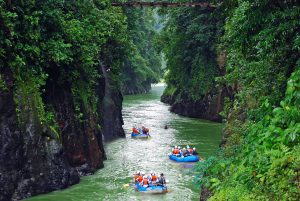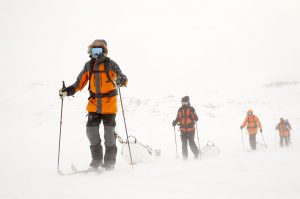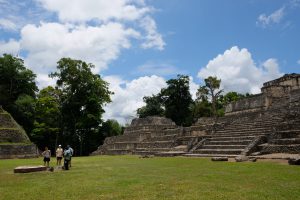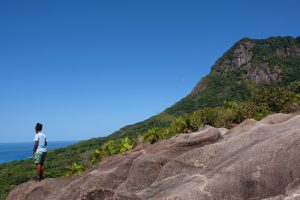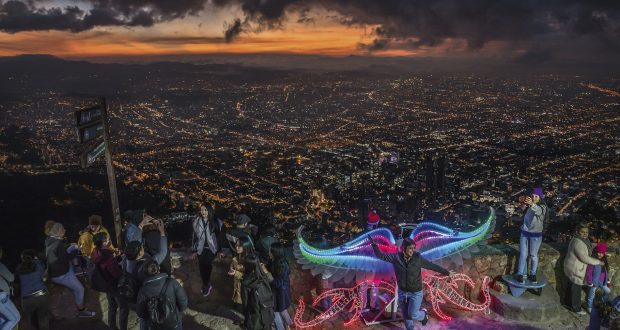
From its colourful, art-enriched streets to the warehouses where explosive games of tejo are played, Colombia’s capital is awash with offbeat charm
Read online at nationalgeographic.com
This is it!” my guide, Beró, confirms breezily, moving towards a warehouse that sounds like it houses a military testing zone. Percussive thuds and sporadic explosions emanate from the building. Earlier, when I’d requested to see a surprising side of Colombia’s historic capital, Beró, a born-and-bred Bogotana, suggested heading to a working-class suburb to try the age-old game of tejo. On the drive over, she’d been deliberately vague about the rules.
Once we’re inside, Beró begins to explain how to play. “It’s two points for an explosion,” she tells me, handing over a beer and a metal puck before steering me towards our lane. “If I’d told you about the explosives beforehand, you’d have thought Colombians were all crazy. As if we haven’t had enough violence in our past!” she jokes, darkly. “It’s best to experience tejo first, to actually play the game, then you can start to understand it.”
Bizarrely and brilliantly, the sport involves hurling metal pucks into a target of sloppy, wet clay laced with sachets of gunpowder. I wildly misjudge my first throw (“Careful! We don’t want to have to replace the ceiling,” Beró shouts), but successfully sink the puck into the mud on my second and, miraculously, set off a blast on my third. The bang fills the hall, eliciting encouraging cheers from other players.
My explosive introduction to tejo over, Beró shows me the headline draws of her hometown — the lofty pilgrimage site of Monserrate on the city’s forested eastern ridge; the elegant colonial-era palaces and cobblestone plazas of La Candelaria, the historic centre; and the renowned Gold Museum, which is home to some of the finest pre-Hispanic metalwork that was fortunate enough to escape the conquistadors’ smelting pots. We also take the time to tour the upmarket northern neighbourhoods: there’s Zona Rosa, with its nightlife and fine-dining restaurants; Usaquén, famous for its fancy flea market; and the gentrified bohemia of artsy La Macarena.
But the city’s real draw lies in its gritty backstreets. There’s a vibrancy and political angle to the street art around La Candelaria, and a touch of magic in the downtown emerald market, where vendors hawk lumpen gems (some fake) from mines surrounding the capital. I fall for the street food — the unimpeachable local chicken soup, ajiaco, and sugary oblea wafer sandwiches — and its one-off shops, like the ramshackle antiquarian bookbinders Ricardo Corazón de Papel. Bogotá has an offbeat charm. The city’s often given short shrift (its detractors cite gridlocked traffic, vast disparities of wealth and its unpredictable, high-altitude climate), and, sure, it lacks the timeless romance of Cartagena or the show-stopping regeneration projects of Medellín. But Bogotá — along with Bogotanos — has heart by the bucketload. Beró even buys me a bunch of flowers when my back’s turned at a local market. It’s much like tejo: you really have to experience Bogotá to understand it.
See & do
Plaza Bolívar: The epicentre of La Candelaria is as historically significant as it is eye-poppingly grand. The square is home to Colombia’s largest cathedral, a towering neoclassical affair housing the relics of the city’s founder, conquistador Gonzalo Jiménez de Quesada. And among the various palaces stands Casa del Florero, the site of events that led to the overthrow of Spanish rule in 1810. The modern Palacio de Justicia has the most dramatic backstory: the first supreme court building was burnt down during the deadly Bogotazo riots of 1948, and it was razed again in 1985 during a military standoff with M-19 guerrillas who’d taken 300 civilians and judges hostage inside.
Monserrate Hill: Pilgrims can regularly be seen ascending the hill’s 1,500 steps to petition the Virgin of Montserrat for miracles at the summit’s rustic church. Join them on foot, or take the funicular or cable-car, for spectacular views across Bogotá’s urban sprawl. The hilltop is also home to Restaurante Casa San Isidro, a popular spot for marriage proposals.
Gold Museum: Colombia’s best museum’s 55,000-piece collection includes the finest pre-Columbian artefacts to have survived the colonial period. Headdresses, jewellery, statues, votive offerings and the fantastic Muisca Raft glow under spotlights in darkened galleries, hinting at half-lost histories and the mysterious religious rites of the native civilisations of the Bogotá valley and beyond. Entry is free on Sundays and there are tours in English twice daily.
Graffiti tour: More popular than all the city’s historic monuments and world-class museums is this incredibly cool, perennially packed free walking tour of the street art of La Candelaria. Starting at Parque de los Periodistas and winding up in the charming restaurant hub of Plazoleta Chorro de Quevedo, the tour artfully deciphers the vibrant murals by internationally renowned local artists including Guache and Rodez, and collectives such as the Mientras Duermen Crew and APC, to tell stories of social and political struggle in the capital.
Botero Museum: Painter and sculptor Fernando Botero is one of Colombia’s most beloved sons, famous for his depictions of exaggerated, plump figures, which can be by turns humorous or politically subversive. This free museum is one of the city’s treasures: in 2000, the artist donated 208 art pieces, 123 of his own and 85 by other international artists, including Salvador Dalí and Pablo Picasso.
Paloquemao Market: On the outskirts of town, this authentic produce and flower market offers a taste of local life. Fuel up on arepas (filled pastries) then hit the stalls for a food safari, starting with the heaps of exotic fruit. First-time visitors can expect to discover new flavours and textures, from the citrus-like lulo with its green flesh to the fibrous, tangy bulbs of mangostino.
The Ciclovía: Bogotá claims to be the most bike-friendly city in South America. Besides its extensive cycle routes, the city actually bans traffic each Sunday morning on all main roads (a 75-mile network) so locals can pedal around uninhibited by fumes and horns. The Ciclovía is a weekly ritual that brings not just cyclists to the streets, but also promenading families, musicians and vendors. It can be embraced on foot or with your own wheels hired from Bogotá Bike Tours.
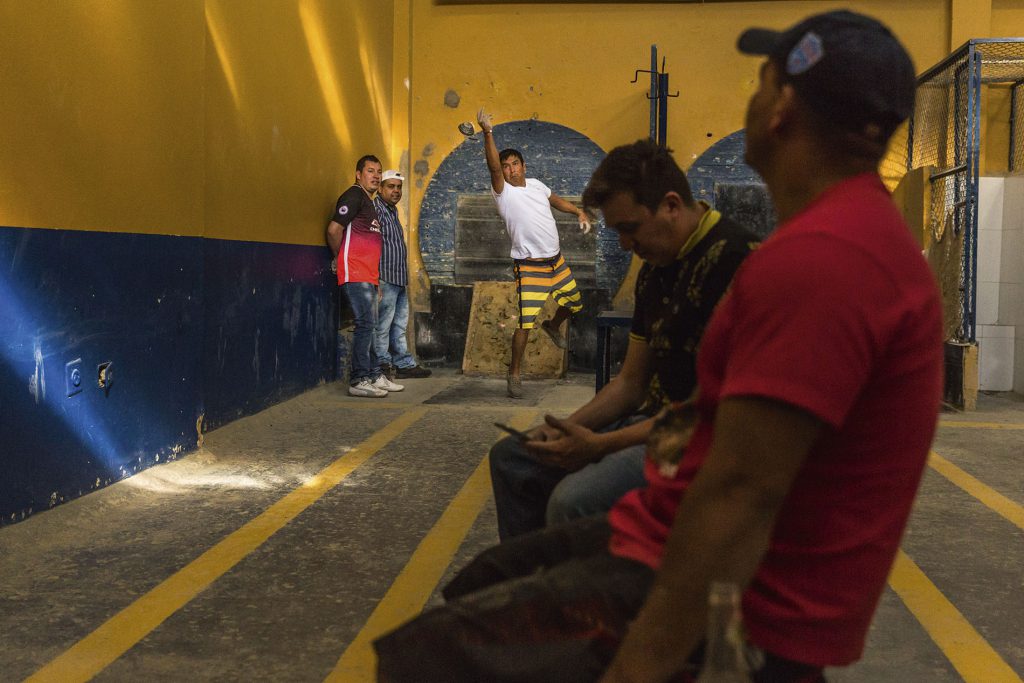
A group of friends gather to play Tejo, a traditional game where a metal disk is thrown in to a clay trying to hit gunpowder cartridges. It a working class game but widely played around the city of Bogota with clubs that offer a smaller court version for beginners. Photo Credit: Juan Arredondo
Buy
Usaquén flea market: Dozens of traders and artisans set up shop in the streets around Usaquén’s little plaza each Sunday, creating arguably the poshest mercado de pulgas in South America. It’s been a popular weekend outing for almost 30 years: busking musicians entertain shoppers, and offerings range from antiques to organic cosmetics.
Ricardo Corazón de Papel: This workshop-cum-emporium of handmade notebooks is presided over by the eponymous Ricardo. The shop’s name, meaning ‘Ricardo, Heart of Paper’, comes from a nickname Colombian author Gabriel García Márquez gave the owner after he made him various bespoke ledgers. Don’t miss the back room dedicated to their friendship and correspondence. Calle 20, No.3-29. T: 00 57 1 34 10 072
Emeralds: The emeralds from the mines north of Bogotá appear in every form imaginable in the shops and stalls clustered around the Gold Museum. One place worth visiting is Joyería Continental; all its gemstones are certified. Colombia produces most of the world’s emeralds, so this is the place to bag a bargain.
Eat
Although not a hard and fast rule, La Candelaria is best for traditional food, La Macarena for quirky bites in hipster joints, and the northerly neighbourhood of Zona G for celebrity chefs and stellar gastronomy.
La Puerta Falsa: This tiny restaurant dates back to 1816 and remains the most atmospheric place to try Bogotá’s beloved local cuisine. For a typical breakfast, there’s chocolate completo — crumble the cheese into the hot chocolate and dunk the almojábana (bun) — or for lunch try a steamed tamal, made from meat and masa (corn dough), and wrapped in a banana leaf.
Bogotá Food Tour: Explore the dining spots of La Macarena on this three-stop tour. English-speaking host Lina takes you to restaurants including cool Sandwich Taller and the traditional La Tapería.
Villanos en Bermudas: In the backstreets of Chapinero, diners meet Argentinean Nicolás López and Mexican Sergio Meza in their open kitchen as they conjure one piquant, provocatively flavoured dish after another.
Sleep
While most travellers opt to stay among the sights of the historic centre, a crop of luxurious boutique hotels have sprung up in recent years around the affluent shopping and nightlife hub of Zona Rosa, making a case for a stay in Bogotá’s north.
Cranky Croc Hostel: The playful name belies the spotless, smart dorms and private rooms at this central hostel in La Candelaria. Breakfast isn’t included, but an on-site cafe is at hand for healthy daytime nibbles and not-so-virtuous cocktails come sundown.
Hotel de la Opera: Once the grandest hotel in the historic centre, Hotel de la Opera’s opulent interiors are now a little faded. The setting, however, in a grand manor house next door to the Teatro Colón, can’t fail to impress.
Four Seasons: This is a slick property with an understated opulence that reflects the urban cool of its setting in Zona Rosa, Bogotá’s upmarket barrio of boutiques and bars. Modern rooms and suites are spacious and bathed in natural light, while communal areas are funky with seating designed for intimate tête-à-têtes.
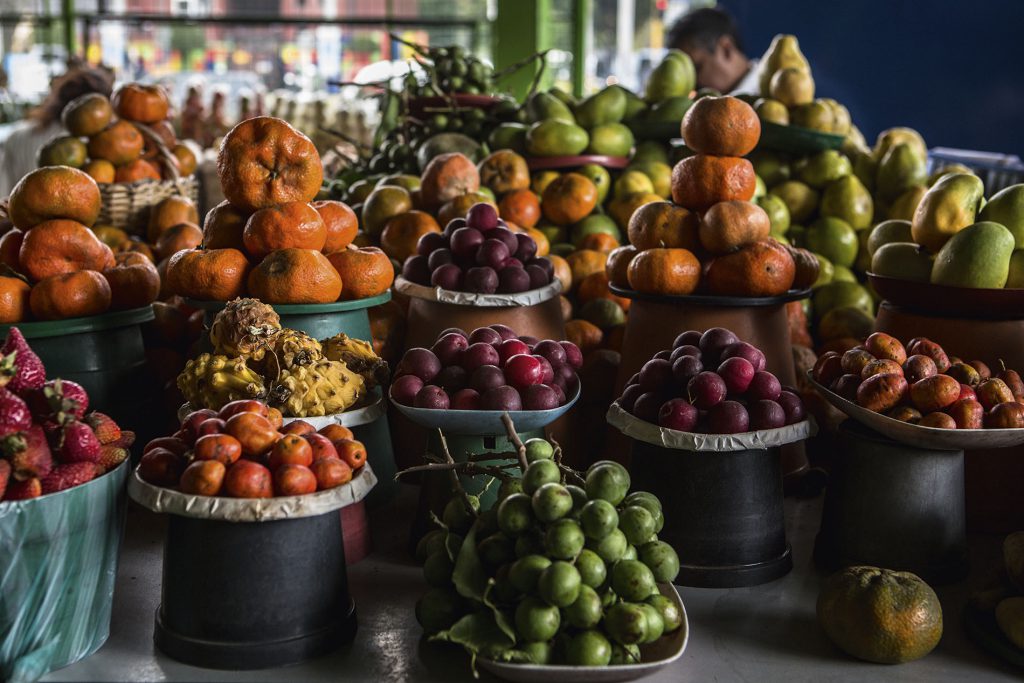
Paloquemao Market: On the outskirts of town, this thoroughly authentic produce and flower market is a taste of local life. Fuel up on some arepas then hit the stalls for a food safari, starting with the market’s heaps of exotic fruits. Photo Credit: Juan Arredondo
Like a local
Like a Rolling Stone: Feeling peckish downtown near the historic Colón Theatre? Look for Mick Jagger. In a bizarre marketing tactic, the face of the Rolling Stones’ frontman has decorated the carts selling sickly sweet obleas (caramel and jam smeared between round, plate-sized wafers) ever since he was snapped enjoying one between stadium gigs.
Café San Alberto: Oddly for a nation of coffee producers, Colombians tend to drink instant. However, the third-generation owners of the San Alberto plantation are looking to elevate local coffee culture, serving up premium blends in their two cafes (one inside the Gold Museum and the other in Usaquén).
Bottoms up: The student bars around Plazoleta Chorro de Quevedo in La Candelaria are the best places to try traditional tipples such as canelazo: a shot of aniseed-flavoured aguadiente heated up with cinnamon and lime. To learn more about the fermented corn brew of chicha, seek out the bar-cum-museum La Bendita Chichería, on the plaza’s northeastern corner.
After hours
From the big, modern bars of Zona Rosa to the cosy joints of La Candelaria, Bogotá really comes to life after dark. However, it’s advisable to avoid walking alone in the historic centre late at night.
Bogotá Beer Company: It might seem odd to drink in a British-style pub in Bogotá, but the BBC spearheaded the capital’s microbrewery revolution. Today there are branches all over town, and the Calle 85 outpost is particularly popular for after-work drinks.
Andrés Carne de Res: Closer in spirit to a circus that a restaurant, this raucous dining establishment 16 miles north of the city centre in Chía has become synonymous with partying in Bogotá. With seating for 2,000 people, entertainment comes from drummers, dancers, clowns and mariachi bands.
Armando Records: This multistorey clubbing staple is fun on every level, from its All Stars bar (bare brick walls, pool tables and a sprinkling of mainstream hits) up through its indoor-outdoor dance hall to its red-lit rooftop space.
ESSENTIALS
Getting there & around
Avianca runs a daily, direct route from Heathrow to Bogotá El Dorado International, which is nine miles northwest of the city centre.Average flight time: 11hr10min
There’s no metro; instead the perennially packed buses of the TransMilenio ferry locals around. Staff speak little English and the network is anything but simple to navigate, so plan your route ahead of time. Alternatively, jump in a yellow cab: fares are very reasonable, although it’s advisable to order one through your hotel or via the Easy Taxi app to avoid unlicensed and possibly unscrupulous drivers.
When to go
Situated 8,500ft above sea level on the country’s highest plateau, Bogotá experiences some of the coolest and wettest weather in the country, although daytime temperatures remain a constant 15-20C year-round. The driest and sunniest months are December and January.
More info
Lonely Planet Colombia (2018). RRP: £17.99
Short Walks from Bogotá (2012), Tom Feiling. RRP: £9.99
Museums. banrepcultural.org
colombia.travel
How to do it
Audley Travel offers a 10-night stay, including four nights in Bogotá, three nights in the coffee region and three nights in Cartagena, from £3,800 per person. The price includes international and domestic flights, accommodation with breakfast, transfers and excursions.
Published in the April 2019 issue of National Geographic Traveller (UK)





